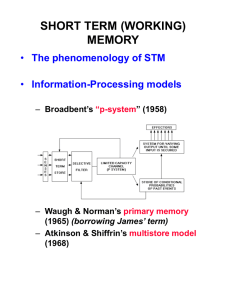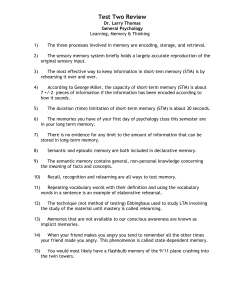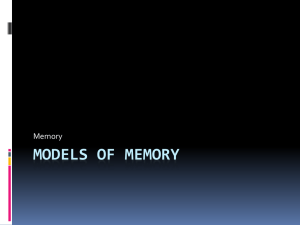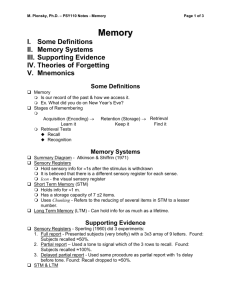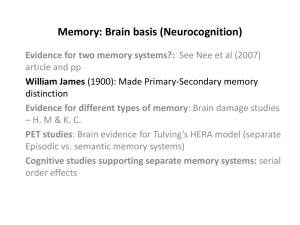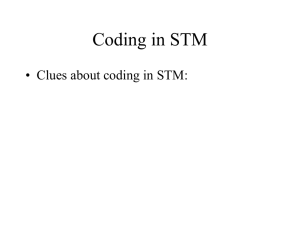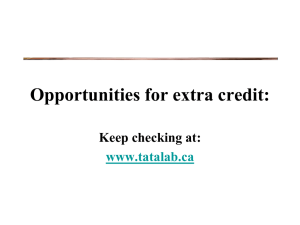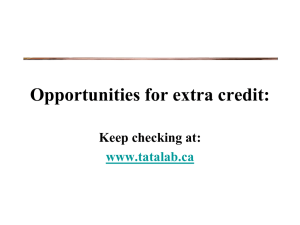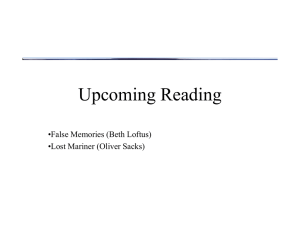Memory 1- Basic of Memory, , Working Memory PERTEMUAN 4
advertisement
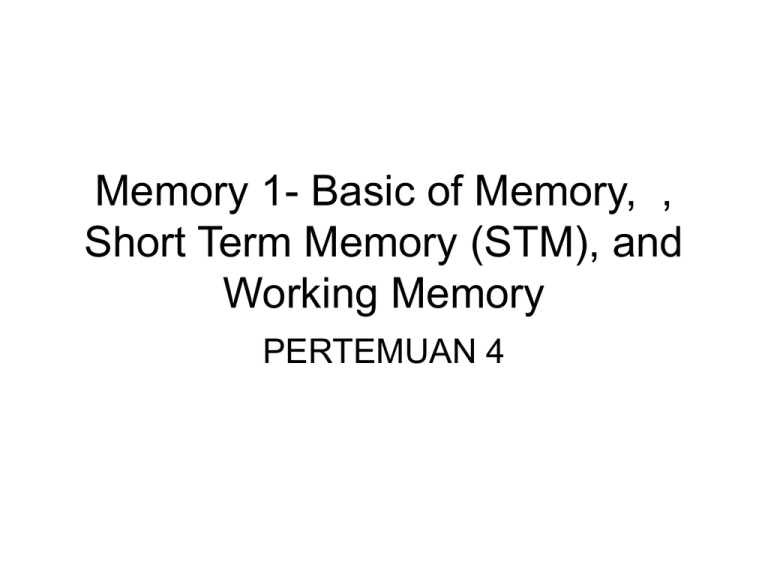
Memory 1- Basic of Memory, , Short Term Memory (STM), and Working Memory PERTEMUAN 4 4.1 Introduction to memory • Memory refers to our ability to: – retain information about past experiences – the processes by which we acquire, record or encode information – the processes by which we store information in an accessible format – The processes by which we can later retrieve that information. Methods of testing memory • Free recall (also called spontaneous recall) – you are required to generate the test items from your own memory without any outside help • Cued recall – you are required to generate test items from your own memory, but with the aid of reminders or ‘retrieval cues’ which may help to jog your memory • Recognition – In a recognition test the original test items are represented at the retrieval stage, and you are merely required to indicate whether or not you recognise them. Multistore models of memory • William James (1890) put forward theories about two types of memory store, which he called ‘primary memory’ and ‘secondary memory’. Now replaced by the terms ‘short-term memory’ and ‘long-term memory’ • Short-term memory (STM) – memories which we are holding in conscious awareness, and which are currently receiving our attention • Long-term memory (LTM) – memories which we are not presently holding in conscious awareness, butwhich are held in storage ready to be recalled. 4.2 Short-term memory • Information from our senses enters shortterm memory (STM) via sensory registers • STM is a temporary store for relatively unprocessed (sound-based or visual) information. – Verbal STM has a limited capacity of 7 ± 2 items, which can be used most efficiently by chunking the information to be remembered. Measuring STM performance Digit span test • 71504 • 284936 • 8351609 • 25736184 • 940627135 Serial position curves for immediate and delayed recall 4.3 Working memory • Working memory refers to the processes that temporarily store and manipulate information so that we can use that information to follow a conversation, solve problems etc. • Baddeley and Hitch’s model of working memory comprises the phonological loop (PL), visuo-spatial sketchpad (VSSP), central executive and, recently, the episodic buffer 4.4 Forgetting and remembering • Two main mechanisms of forgetting, from STM or LTM, have been proposed. – Decay theory proposes that memory fades with time – Interference theory proposes that forgetting occurs because memories disrupt with each other. 4.5 Limits and failures of memory • Case study: Temporal lobe surgery (HM) 4.6 Mental representation • A representation is a sign, symbol or token that ‘re-presents’ something in its absence • analogue representations – representations bear some physical resemblance to the object or event they represent. – For example, a painting or scale model of a town may retain the structural features and spatial layout of the buildings and streets in that town. • symbolic representations – do not resemble the represented object or scene in any way. – For example linguistic representations, letters and words are arbitrary symbols that bear no physical relation to the phonemes or items they represent. – they symbolize rather than mimic the thing they stand for Imagery • Mental imagery provides us with a way of experiencing novel situations or re-experiencing past events • Baddeley (1986) assumed that visual imagery is a function of the visuo–spatial sketchpad (VSSP) of working memory. • Logie, Zucco and Baddeley (1990): – visual imagery interferes more with visual short-term memory (STM) than with verbal STM – whereas mental arithmetic interferes more with verbal STM than visual STM. Concepts • A concept is a unit of knowledge that allows us to recognize novel stimuli as types of thing we have encountered before • typicality effects Connectionism • Connectionist models exhibit parallel distributed processing (PDP).



